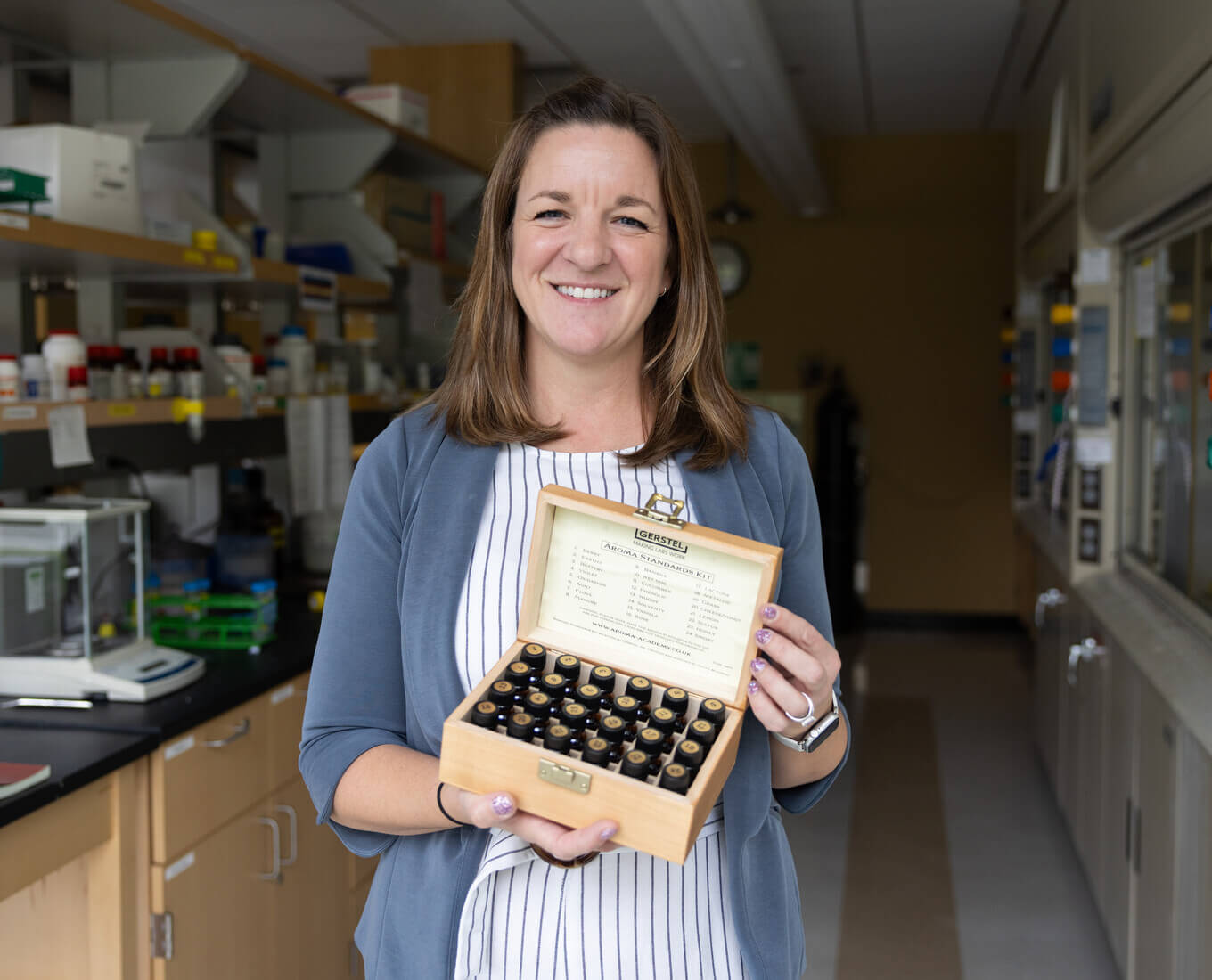 For 106 students, the summer was spent pushing intellectual boundaries and creativity while conducting leading research across a range of disciplines: 61 students engaged in research in the sciences; 38 in the humanities, social sciences, and fine arts; and seven in economics.
For 106 students, the summer was spent pushing intellectual boundaries and creativity while conducting leading research across a range of disciplines: 61 students engaged in research in the sciences; 38 in the humanities, social sciences, and fine arts; and seven in economics.
The myriad of research projects gave students the opportunity to dive into topics that intrigue them through intensive, focused projects under the guidance of faculty members who acted as both advisors and research partners. Research took place in labs and libraries on campus, as well as onsite both locally and internationally.
Explore a selection of the projects our students participated in this summer:
Bees, Bees, Bees

Project: "Investigating the Stimuli of Hygienic Behavior in A. mellifera"
Student Researcher: Anthony Criscitiello '17, biology major with a biochemistry concentration in the College Honors Program
Faculty Advisor: Karen Ober, associate professor of biology
The Research: This summer, Criscitiello studied the chemical mechanism of social immunity in honeybee colonies. He explains that honeybee social immunity is based on the ability of nurse bees to detect diseased or dying larvae, something that all strains of honeybees can do, but that only specific strains accomplish at a substantial rate. The nurse bees' behavior is responsible for stemming disease that would otherwise lead the hive to collapse. Criscitiello studied the detection aspect of this hygienic behavior, which he hypothesizes relies on the ability of nurse bees to detect changes in the pheromones given off by diseased larva.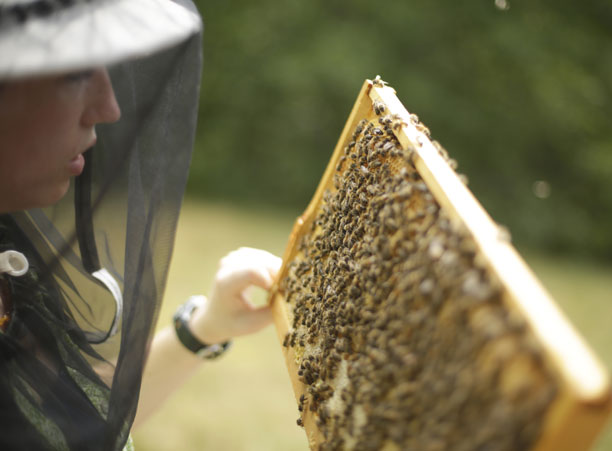
Project: "The plant-pollinator interaction revisited: do honeybees prefer plants that offer antimicrobial, antiviral and fungicidal compounds in nectar"
Student Researcher: Mary Patrice Hamilton '17, biology major
Faculty Advisor: Karen Ober, associate professor of biology
The Research: Previous studies have established that herbaceous plants — such as oregano, thyme, lavender, and mint — offer pollination rewards for honeybees in the form of sugary nectar, the honeybees' energy source, and pollen, their sole protein source, explains Hamilton. Other studies have explored the oils of these plants, reporting the compounds in the oils to have antiviral, antibacterial, and fungicidal properties. In her summer research, Hamilton explored whether these qualities in the nectars of herbaceous plants further attract honeybees to them, adding another element to this plant-pollinator relationship.
Hamilton and Criscitiello spent their summers tending to honeybees — approximately 100,000 honeybees that is — tucked away in a corner of College Hill. Not only are they responsible for maintaining the six hives on campus, but they were instrumental in bringing them to Holy Cross in the first place. They were inspired to begin the process during their first year, when the Community Based Learning component of Hamilton's Montserrat class caused her to take a closer look into issues of food justice, a concern she then shared with Criscitiello.
"Our main concern was, 'What can we do to supply underprivileged people with quality produce?' This was when the importance of honeybees and native pollinators came into focus," says Criscitiello.
With the help of Justin McAlister, assistant professor of biology, Hamilton and Criscitiello had their first hive on campus in June of 2015, a population that has multiplied six times in the subsequent year and that is solely Hamilton and Criscitiello's responsibility to manage.
A year later, the students are working with the hives to conduct research on topics important to honeybee populations.
"The possibility of contributing to a solution to a large humanitarian problem, pollination and food cost, is a large part of my motivation to pursue honeybee research," shares Criscitiello.
This focused research has added a new layer to an already dynamic learning experience for Hamilton and Criscitiello.
"We've always been independent and worked hard to become the best beekeepers we can be and learn from our mistakes and listen to new ideas, but I think working with Professor Ober this summer made me a more independent scientist," says Hamilton. "I learned when I needed to ask for help and when I needed to work harder to figure out a better solution."
Both students will continue their research and work with the honeybees during the academic year, with the hopes of continuing in the field after graduation, bringing the experience, knowledge, and passion for honeybees gained at Holy Cross with them.
Read more about the project in the Fall 2016 issue of Holy Cross Magazine.
Geometry & Knitting
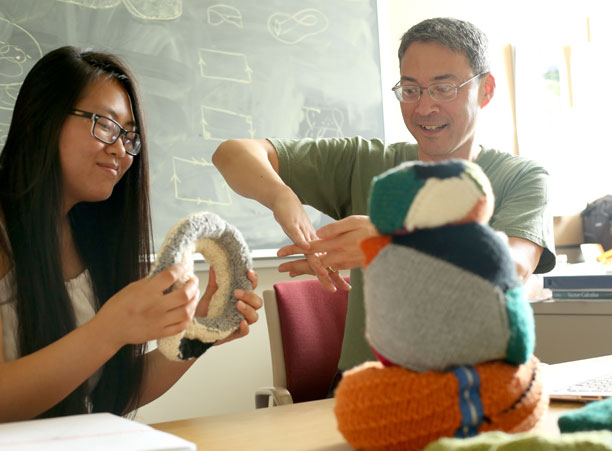
Project: "When Fiber Arts Joins Mathematics"
Student Researcher: Ellen Chen '17, mathematics major and visual arts history minor
Faculty Advisor: Andrew Hwang, associate professor of mathematics
The Research: Chen's research focused on the study of geometric surfaces, such as Möbius strips, Klein bottles, and tori. For her project, Chen knitted models of these surfaces using straight and circular needles, acrylic yarn, and zippers, through which she was able to illustrate the curvature and flatness of the surfaces.
While studying abroad at the University of York in England during the last academic year and thinking forward to life after graduation, Chen was entertaining the idea of pursuing a graduate degree in mathematics, but wasn't sure whether she'd enjoy conducting research.
"When I was catching up with Professor Ballantine (professor of mathematics) over coffee during my winter break last December," says Chen, "she suggested that I apply to the summer research program."
After reaching out to Hwang about conducting research, and identifying which area of mathematics to study, Chen discovered other mathematicians who used knitting to communicate mathematical concepts, inspiring her to design this project.
"The highlight of this research project was that I got the opportunity to combine my hobby of knitting with my studies in mathematics," shares Chen, who before having conducted this research had never take any upper level geometry courses. Drawing on her own motivation, Chen independently studied geometry and topology in preparation for her summer research, further supported by her direct work with Hwang over the summer on campus.
"Genuine, transformative learning results from extended relationships between particular people," says Hwang. "In this sense, every close interaction between a curious student and a knowledgeable teacher is valuable. Ellen's summer project gave the two of us the flexibility to find an area where her interests and curiosity overlapped with my mathematical training."
Worcester's Irish

Project: "Worcester's Saint Patrick's Day Parade of 1890"
Student Researcher: James O' Connor 18, history and political science double major in the College Honors Program
Faculty Advisor: Justin Poché, associate professor of history
The Research: While O'Connor initially aimed to explore industry in Worcester and the Irish labor experience, his focus instead shifted to the city's Saint Patrick's Day Parade of 1890 — a major event for the struggling Irish immigrants of the time — after encountering multiple mentions of it in his initial research. Using the parade as a focal point, O'Connor was able to study the existing conflict at the time between the Irish citizens rallying behind the temperance movement, and Irish traditionalists who didn't view sobriety as the answer and who had a strong desire for unity and continued connection to Ireland. The parade marked the first time the opposing groups worked together, which made it an ideal lens through which to study the conflict.
O'Connor read through a variety of original sources — from 1890's newspapers to diaries — at the Holy Cross Archives and Special Collections, and the American Antiquarian Society in Worcester, dispelling his original fear that there wouldn't be enough material to conduct his research.
"I learned about the traditions of the city, the important sites where prominent men met, and the railroads that the Worcester Irish built in the early 1800s," says O'Connor. "My research absolutely helped me gain a greater appreciation for Worcester."
This summer research project gave O'Connor the opportunity spend a bit more time on campus before studying abroad in La Coruña, Spain for the upcoming year, but more importantly, it gave him the space to gain valuable independent research experience under the guidance of Poché. "Each day I learned more about the proper way to conduct research," says O'Connor.
Poché sees the summer research as an opportunity to share his passion for research with students like O'Connor.
"I've always felt most at home in archives, and the opportunity to share the excitement that comes with encountering these voices from the past while bringing fresh perspectives and questions is a real privilege," shares Poché. "Students' first-hand experience with historical research helps them develop tools that will always be relevant and necessary in whatever field and vocation they pursue.
"These are, of course, goals for all of my courses," he continues, "but I really think summer offers a freedom to be confused, frustrated, and energized by the work in very creative and productive ways."
Community Gardens on the Hill

Project: Community Garden Intern
Student Researcher: Nathaniel Hunt '18, economics major and environmental studies minor
The Research: Kale, tomatoes, eggplants, basil...these are just a few of the different vegetables and herbs Hunt was responsible for planting and maintaining this summer in the Holy Cross Community Garden, which consists of 11 raised beds in two locations on campus. In addition to learning about agriculture and plant physiology in his day-to-day work with the garden, Hunt investigated the logistical and financial feasibility of a campus farm at Holy Cross, exploring campus farms at other institutions and estimating annual revenues and costs of such a project.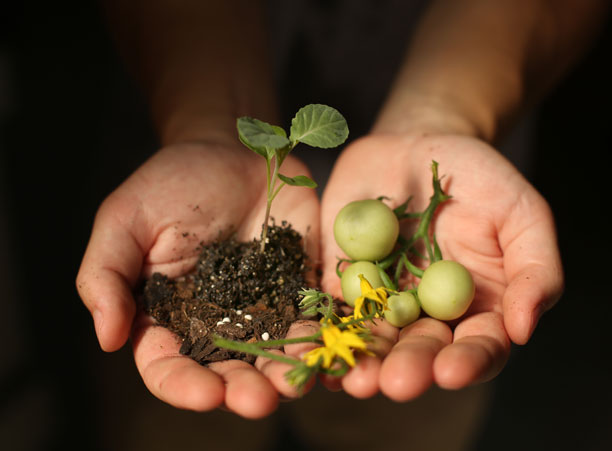
In preparation for Holy Cross' first academic year with a community garden, Hunt explains that he also spent time organizing a club around the garden, planning harvests and meals with various courses that deal with food, and finding ways to help and involve the local community.
"The hope is that the garden will serve as an educational tool that allows students, faculty, and staff to learn and discuss the environmental and social ethics of food production in a practical and hands-on manner," says Hunt. "We also hope the garden will allow Holy Cross to give back to the Worcester community in the form of educational programming for local students and donations of fresh produce to local food banks."
Hunt's interest in community gardens began during his Montserrat class, "Farming and the Food Industry," with Robert Garvey, associate professor of physics. "The class covered humanity's progression from hunting and gathering to the industrialized food system we have today, and the environmental and ethical consequences of that current system," explains Hunt. "I became inspired to help make a difference, and saw the garden project as an excellent catalyst to creating bigger changes at Holy Cross."
The community garden was launched in the Spring of 2016, a result of the work of Matthew Watson '16, Stephanie Crist, visiting assistant professor of sociology, and Daina Cheyenne Harvey, assistant professor of sociology, and continued to flourish through the summer with guidance from Robert Bertin, Anthony and Renee Marlon Professor in the Sciences.
Read more about the community gardens in the Fall 2016 issue of Holy Cross Magazine.
Lab Discoveries
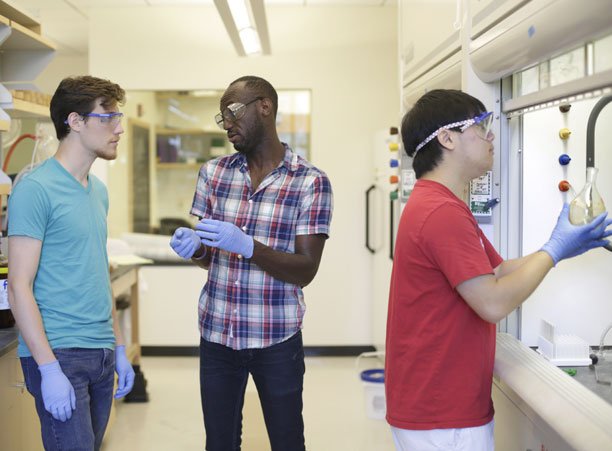
Project: "Copper-catalyzed approach to Aminoindolizines"
Student Researcher: Benjamin Ghiano '17, chemistry major, and Tae Correia '17, chemistry major
Faculty Advisor: André Isaacs, assistant professor of chemistry
The Research: After the facile synthesis of the very reactive intermediate ketinimine was achieved in 2004 through the use of "click chemistry," the door was open for its reactivity to be probed, according Isaacs, who's lab is exploring this exactly. "We aim to discover new ketenimine coupling partners and employ the reactivity in new ways to obtain biologically relevant structures as well as improve upon known strategies to make valuable synthetic intermediates in this highly productive one-pot sequence of transformations," Isaacs explains.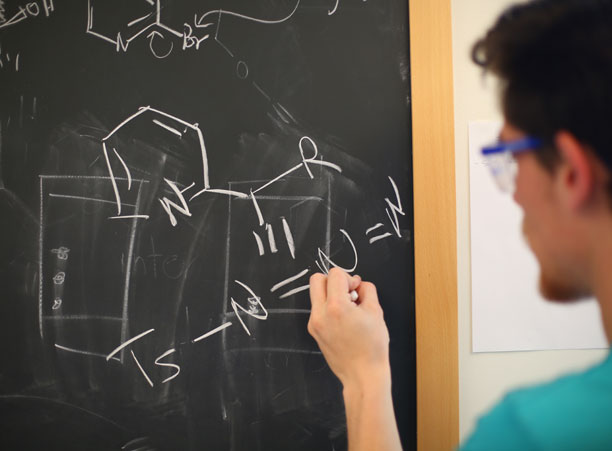
Correia and Ghiano spent the summer in Smith Labs 361, located in the Integrated Science Complex, utilizing a coupling partner for ketenimines they and Isaacs discovered to synthesize the core of a wide variety of naturally occurring compounds with interesting biological activity. These compounds have a range of potential applications — from being used as fluorescent dyes or in photographic material to being used as microbial agents.
"Professor Isaacs gives us the ability to work independently so I was immediately able to make a contribution to our publication every time I ran a reaction," says Ghiano.
Both students were excited for the opportunity to conduct research full time over the summer, without the competing demands of the semester, and both plan to continue the research when they return to campus in the fall.
"We were extremely productive this summer so we don't exactly expect to have the same level of intensity during the semester, but the training, troubleshooting experience, and problem solving ability gained in the summer will certainly carry over into the academic year," Ghiano shares.
In addition to practically learning what it takes to convert an idea into real results, the students made real contributions to the project, mostly through developing the optimal conditions needed for the transformation, running approximately 30 test reactions, explains Isaacs.
"We coordinated experiments, tallied results, and consulted each other on a daily basis," Isaacs says. "I was very impressed by their ability to work together in a very efficient manner and am very grateful for the opportunity to mentor and work alongside these students who really valued this experience."
Textiles in Southeast Asia
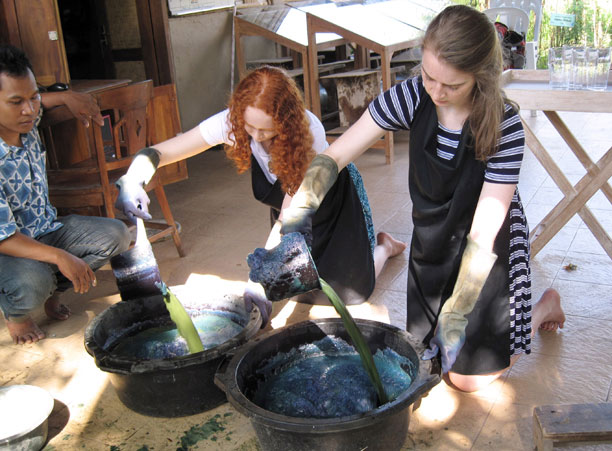
Project: "Woven Power" exhibition
Student Researchers: Megan Demit '16, sociology major and visual arts studio minor; Melissa Gryan '18, classics and visual arts history double major; Margaret MacMullin '16, classics major and visual arts studio minor; and Martina Umunna '18, history major, Asian studies and visual arts studio double minor
Faculty Advisor: Susan Rodgers, emerita professor of anthropology and emerita Distinguished Professor of Ethics and Society
The Research: Chosen as the four docents for the "Woven Power: Ritual Textiles of Sarawak and West Kalimantan" exhibition in the Cantor Art Gallery this fall, Demit, Gryan, MacMullin, and Umunna spent the summer exploring Southeast Asian ritual textiles — first on campus and then directly in Southeast Asia.
The first ten days of their fieldwork were spent in Indonesia, studying the textile making process, specifically natural dye work, ikatting techniques, and batikking, at the NGO Threads of Life in Ubud, Bali, Indonesia; talking with weavers in the double ikat weaving village of Tenganan Pegeringsingan, Bali; and studying the production of ikat on semi-mechanized looms in the endek weaving town of Sidemen, East Bali. The following eight days were spent in Kuching, Sarawak, Malaysia, where the students interviewed weavers and museum staff at the Tun Jugah Foundation, as well as weavers and heritage cloth brokers in shops and other museums in Kuching. The research trip was capped off with a study tour of the Asian Civilisations Museum in Singapore.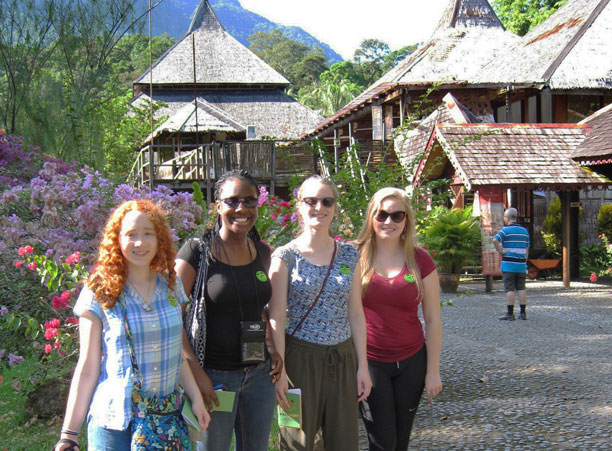
After taking Rodgers' Fall 2015 "Art and Power in Asia" course on the politics of museum representation of Asian societies and Asian arts in American museums, all four students were interested in becoming docents for the upcoming exhibition, continuing to explore the fields of museum representation and Asian arts under Rodgers.
"I was able to learn about the lasting effects of colonialism on cultural objects in Southeast Asia," Umunna says about the course. "I wanted to continue this study as it matched both my interest in colonial history and my love of Asian cultures, so when Professor Rodgers mentioned in her class that she needed docents/researchers for her upcoming exhibit, I jumped on the opportunity."
During their fieldwork, the students were able to match classroom lessons with praxis, dramatically increasing their understanding of Southeast Asian textiles in the span of 20 days.
"The highlight of the fieldwork experience was the morinda dye lessons," says Gryan. "We had been reading about these complex dying processes while we were at Holy Cross. The lessons gave me a new appreciation for the labor intensive dyeing process and they helped solidify my understanding of the steps."
Back on campus and armed with the first-hand knowledge gained during their travels, the students prepared a video and photo display describing their textile studies to compliment the exhibition and worked to co-author the exhibition brochure with Rodgers.
During the run of the exhibition, from Aug. 31 to Dec. 14, Rodgers, Umunna, and Gryan will give nine gallery tours to members of the community, and Rodgers, along with all four researchers will present a joint research lecture on Sept. 7, the formal opening day of the exhibition, at 4:30 p.m. in Rehm Library.
The impact of the summer research experience, however, will continue even after the close of the gallery.
"Doing an eight-week research project was a valuable skill-building experience," shares Gryan. "It gave me a chance to hone my note-taking, writing, editing, and research skills. I had more autonomy and a more singular focus than I would when taking classes, which helped me discover and practice more efficient ways to research."
Latin American Cinema & the Web

Project: "Cinegogía"
Student Researcher: Jeimy Hernandez '18, psychology and Spanish double major
Faculty Advisor: Bridget Franco, assistant professor of Spanish
The Research: Franco and Hernandez spent the summer developing "Cinegogía," a bilingual website for pedagogical resources in Spanish and English related to Latin American Film Studies. The website, which Franco is developing for the Latin American Studies Association and that will be linked to from their website, came out of a desire to increase the profile of Latin American cinema in the field of film studies. The open-access website includes syllabi for teaching film using different disciplinary and interdisciplinary approaches, a searchable database of Latin American films, guides for frequently taught movies, other course materials, and links to resources for teaching Latin American film, explains Franco.
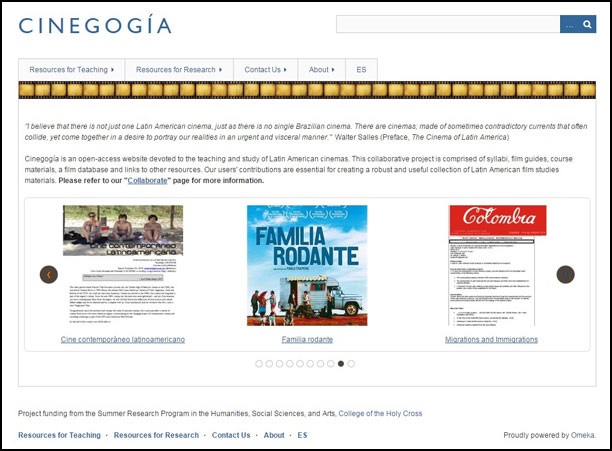 Image of website, Cinegogía, developed by Franco and Hernandez this summer
Image of website, Cinegogía, developed by Franco and Hernandez this summer"Jeimy has deployed this unique and hybrid skill set to develop a robust database using materials from the U.S. and Latin America, resulting in a professional-grade web platform," says Franco.
Over the summer, Hernandez worked on the website in different capacities, including designing the site, contacting potential contributors, and uploading items to build the site.
"The most rewarding part of working on this project was learning about the subject of the website while also gaining many computer science skills," says Hernandez, who, after completing this research, is interested in taking computer science courses to furthering the skills she gained this summer.
Hernandez credits her growth as a student to Franco's mentorship and guidance during the research project. "Honestly, I don't think I would have found anyone better to work with than Professor Franco. She has been my academic advisor for two years now and we have built a great relationship."
Visit Cinegogía, which will continue to be developed and grow, to see Franco and Hernandez's work.
The student researchers will showcase their work at this year's 23rd Annual Summer Research Symposium on Friday, Sept. 9 from 1–4 p.m. in the Hogan Campus Center Ballroom.
View the list of symposium presenters, poster titles, and descriptions (.pdf)
Images by Tom Rettig
Related Information
- Fall 2016, Holy Cross Magazine: "The Bees and Their Keepers"
- Fall 2016, Holy Cross Magazine: "Community Gardens Bloom on Campus"
